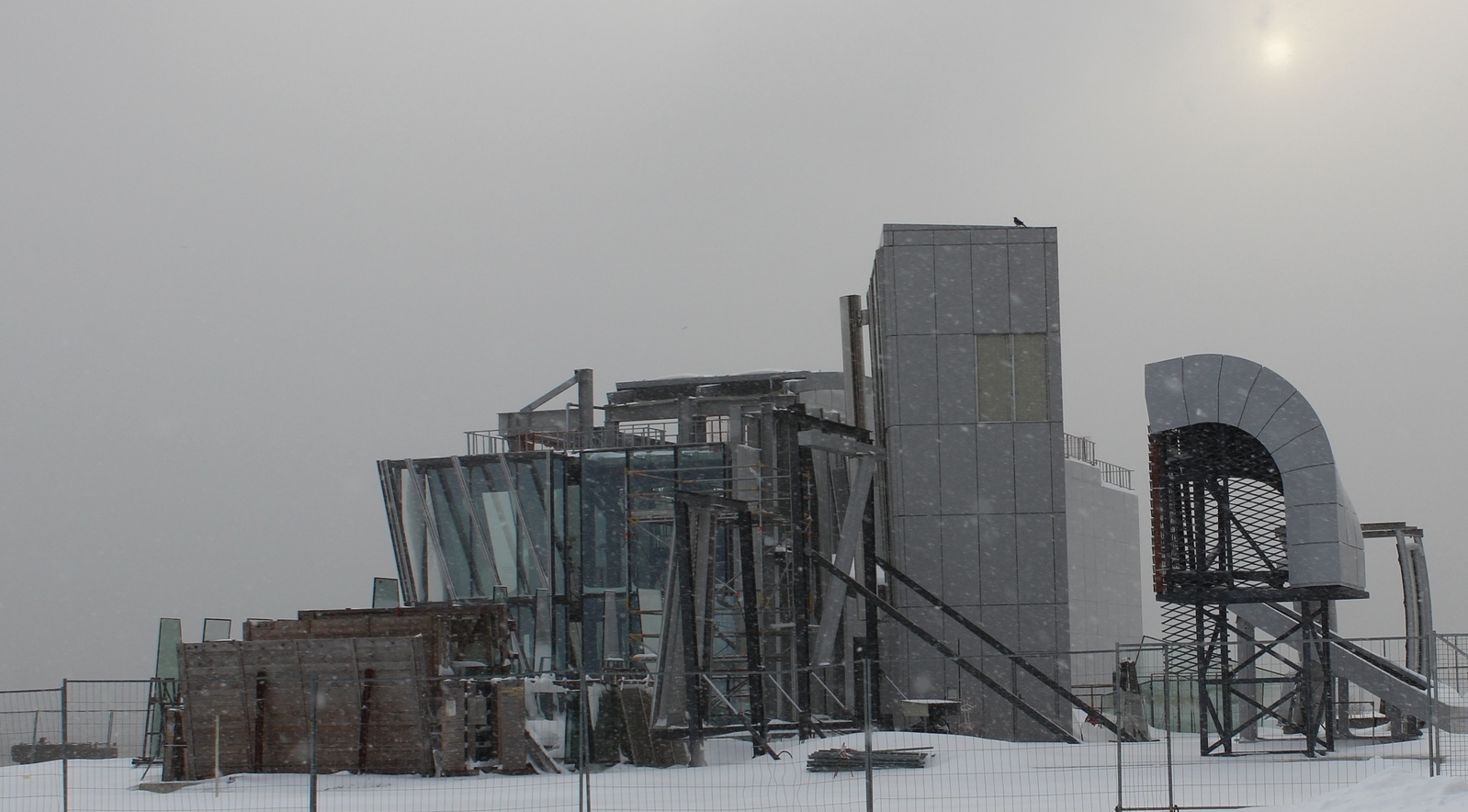Ice and wind. How to solve climatic problems for the northernmost skyscraper of the world
How climate problems are solved for the northernmost skyscraper of the world - the Lakhta Center Tower. Overview in two parts. Today is a problem about ice.
Icicles and icing is a classic Petersburg problem. Its significance is demonstrated by the fact that for some time it even has “dialectism” - “sosuli”: once said, it was actively distributed to the masses. This folklore vividly reflects the climate, famous for its humidity, wind and cold, and also respectful attitude towards a serious opponent.

St. Petersburg "Sosuli" ( photo Yuri Belinsky, ITAR TASS)
')
Partly, precisely because the problem has a pronounced Petersburg flavor, partly because the Lakhta Center will become the northernmost skyscraper of the world, taking away the title from the current owner, Yekaterinburg Vysotsky, the project implementers solve the problem of anti-icing of the tower without half measures, using recent technological advances in this area. In the case of the 462-meter tower, surrender to the “sosul” is simply impossible. The struggle lies ahead with active and passive methods.

"Lakhta Center" - only about 1000 km to the latitude of the Arctic Circle
Icing will mainly occur in the spire zone of the skyscraper and, to a lesser extent, on the highest floors of the tower.

Under the spire. Visualization of the participants of the Archbishop V. Prudnikova and E. Galkin
The height of the spire of the Lakhta Center tower is about 96 meters. The last "habitable" space, before the spire begins - a viewing platform, for which ice patterns on the glass is an unacceptable "decoration".
The main guides in the area of the spire are closed by a dense front part, and between them is a grid that unites all this.

Full-scale modeling: samples of more than 50 types of facades are being tested at a special site, which will be used at the Lakhta Center

Layouts of two spike mesh patterns

The task of modeling is to achieve the absence of a visually discernible transition from the glass of the tower to the grid of the spire.
No one in the world struggled with the icing of the nets. Partly - because the grid itself is an anti-icing measure due to the reduction of the area of interaction of metal and water. The cellular structure makes it impossible to form a solid ice layer, which is the main danger.

Collapse of a continuous layer from the roof. (c) Edinburgh. Frame from video

The formation of snow on the grid - nothing to collapse.
But, as we have already established, the St. Petersburg climate and the title of the “most northern” one makes its own corrections and the grid alone is not enough to solve the ice-breaking problem. We need to act actively.
Now the designers of the Lakhta Center are considering a combination of two technologies that can put an end to the issue of icing the spire and the upper floors of the tower. Most likely, at the moment when you read this material, the testers do their cold work - they freeze and “thaw” the samples of grids and facades. Two independent institutes participate in testing - now Moscow, then front elements will go to Canada.
What technologies are we talking about?
According to the plan, special thin elements will be located on the solid metal elements of the facade, which, under certain environmental conditions, are heated to a sufficient temperature and do not allow the ice to grow. Ice is coming off at that moment when it does not pose any danger yet.

Testing of anti-icing systems of the “Lakhta Center” facades
A similar principle is used on the grid. Vibration is involved here. Once a small layer of ice has formed, a short pulse is given, which shakes the grid.
Heating systems are planned to be used to the level of the observation platform, and vibration - higher.

Test spike mesh de-icing system
We will tell you about the results of a series of anti-icing tests after their completion.
According to available information, on the Ostankino television tower and even on the newest World Trade Center skyscraper in New York, the struggle with icicles is traditional, in the old fashioned way - every winter people build passages from plywood and plywood so that people can walk up to the building. So, “Lakhta Center” in solving the ice-fighting task, definitely has something to be proud of.

Construction of the fence from the "sosuley" around the World Trade Center (NY) (photo from here )
Icebreakers
Icicles and icing is a classic Petersburg problem. Its significance is demonstrated by the fact that for some time it even has “dialectism” - “sosuli”: once said, it was actively distributed to the masses. This folklore vividly reflects the climate, famous for its humidity, wind and cold, and also respectful attitude towards a serious opponent.

St. Petersburg "Sosuli" ( photo Yuri Belinsky, ITAR TASS)
')
Partly, precisely because the problem has a pronounced Petersburg flavor, partly because the Lakhta Center will become the northernmost skyscraper of the world, taking away the title from the current owner, Yekaterinburg Vysotsky, the project implementers solve the problem of anti-icing of the tower without half measures, using recent technological advances in this area. In the case of the 462-meter tower, surrender to the “sosul” is simply impossible. The struggle lies ahead with active and passive methods.

"Lakhta Center" - only about 1000 km to the latitude of the Arctic Circle
Icing
Icing will mainly occur in the spire zone of the skyscraper and, to a lesser extent, on the highest floors of the tower.

Under the spire. Visualization of the participants of the Archbishop V. Prudnikova and E. Galkin
The height of the spire of the Lakhta Center tower is about 96 meters. The last "habitable" space, before the spire begins - a viewing platform, for which ice patterns on the glass is an unacceptable "decoration".
The main guides in the area of the spire are closed by a dense front part, and between them is a grid that unites all this.
Full-scale modeling: samples of more than 50 types of facades are being tested at a special site, which will be used at the Lakhta Center

Layouts of two spike mesh patterns

The task of modeling is to achieve the absence of a visually discernible transition from the glass of the tower to the grid of the spire.
No one in the world struggled with the icing of the nets. Partly - because the grid itself is an anti-icing measure due to the reduction of the area of interaction of metal and water. The cellular structure makes it impossible to form a solid ice layer, which is the main danger.

Collapse of a continuous layer from the roof. (c) Edinburgh. Frame from video

The formation of snow on the grid - nothing to collapse.
But, as we have already established, the St. Petersburg climate and the title of the “most northern” one makes its own corrections and the grid alone is not enough to solve the ice-breaking problem. We need to act actively.
Now the designers of the Lakhta Center are considering a combination of two technologies that can put an end to the issue of icing the spire and the upper floors of the tower. Most likely, at the moment when you read this material, the testers do their cold work - they freeze and “thaw” the samples of grids and facades. Two independent institutes participate in testing - now Moscow, then front elements will go to Canada.
What technologies are we talking about?
According to the plan, special thin elements will be located on the solid metal elements of the facade, which, under certain environmental conditions, are heated to a sufficient temperature and do not allow the ice to grow. Ice is coming off at that moment when it does not pose any danger yet.

Testing of anti-icing systems of the “Lakhta Center” facades
A similar principle is used on the grid. Vibration is involved here. Once a small layer of ice has formed, a short pulse is given, which shakes the grid.
Heating systems are planned to be used to the level of the observation platform, and vibration - higher.

Test spike mesh de-icing system
We will tell you about the results of a series of anti-icing tests after their completion.
P.S
According to available information, on the Ostankino television tower and even on the newest World Trade Center skyscraper in New York, the struggle with icicles is traditional, in the old fashioned way - every winter people build passages from plywood and plywood so that people can walk up to the building. So, “Lakhta Center” in solving the ice-fighting task, definitely has something to be proud of.

Construction of the fence from the "sosuley" around the World Trade Center (NY) (photo from here )
Source: https://habr.com/ru/post/372861/
All Articles